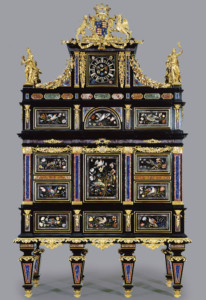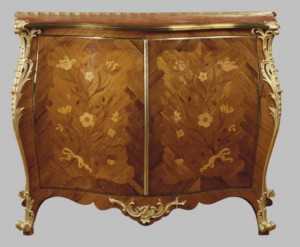Hardstone inlays :
‘Marquetrie’ work was rare in England until the reign of Queen Elizabeth I, 1533-1603, but had been practised in Italy in the 16th century when hardstone inlays were highly fashionable. This technique was generally known in England as ‘Pietra Dura’, Italian for ‘hard stone’. It could be claimed that the Romans were the initiators of ‘marquetry’ work in their ancient mosaics and marble floors.
The Badminton Cabinet. A fine example of Florentine pietra dura marquetry work ca. 1726.
Wood inlays :
Inlaying in wood was practised in the Low Countries as early as 1500, and adopted in France in the next century satisfying the taste and huge demand for opulence during the reign of Louis XIV 1638-1715. Some rare examples of English Elizabethan ‘marquetry’ exist particularly in wainscot chairs, court cupboard fronts , coffers, aprons on some refectory tables, and various other early items of oak offering convenient flat surfaces. A word of caution: because of the rarity of this work many items of oak were later inlaid with holly, ebony & bog oak. Later inlay will dramatically affect value. Most early inlay was geometric. Shaped marquetry came later.
Marquetry work that you are most likely to encounter was introduced into England at the restoration of Charles II, 1630-1685, along with the arrivals in England of large numbers of Continental master craftsmen particularly in the early 18th century. Costly items of superb floral marquetry were created for the English taste. Popular forms were cabinets and longcase clock cases.
See below a floral marquetry bureau cabinet ca. 1760,
[fusion_builder_container hundred_percent=”yes” overflow=”visible”][fusion_builder_row][fusion_builder_column type=”1_1″ background_position=”left top” background_color=”” border_size=”” border_color=”” border_style=”solid” spacing=”yes” background_image=”” background_repeat=”no-repeat” padding=”” margin_top=”0px” margin_bottom=”0px” class=”” id=”” animation_type=”” animation_speed=”0.3″ animation_direction=”left” hide_on_mobile=”no” center_content=”no” min_height=”none”]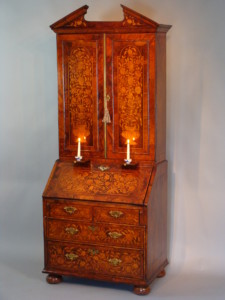
Brass marquetry:
Andre Charles Boulle (Paris, 1642-1732) was one of, if not the most eminent artist working in marquetry in France under the patronage of King Louis XIV. His forte was inlaying complex thin cut brass into tortoiseshell. He did this producing many masterpieces. See in particular a marvellous wardrobe in the Louvre Museum, Paris. There are 22 items by Boulle in the Wallace Collection in London.
[/fusion_builder_column][fusion_builder_column type=”1_1″ background_position=”left top” background_color=”” border_size=”” border_color=”” border_style=”solid” spacing=”yes” background_image=”” background_repeat=”no-repeat” padding=”” margin_top=”0px” margin_bottom=”0px” class=”” id=”” animation_type=”” animation_speed=”0.3″ animation_direction=”left” hide_on_mobile=”no” center_content=”no” min_height=”none”]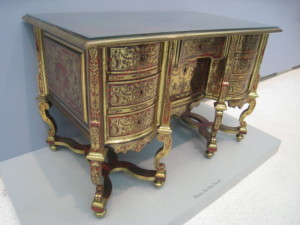
Later in the 18th century marquetry by French master ebenistes reached new heights. They include commodes, cupboards, bureau plats, clock cases, pedestals, bureau cabinets etc. Many French master ebenistes signed their work, unlike their English counterparts.
See below for an example from Box House Antiques:
[/fusion_builder_column][fusion_builder_column type=”1_1″ background_position=”left top” background_color=”” border_size=”” border_color=”” border_style=”solid” spacing=”yes” background_image=”” background_repeat=”no-repeat” padding=”” margin_top=”0px” margin_bottom=”0px” class=”” id=”” animation_type=”” animation_speed=”0.3″ animation_direction=”left” hide_on_mobile=”no” center_content=”no” min_height=”none”]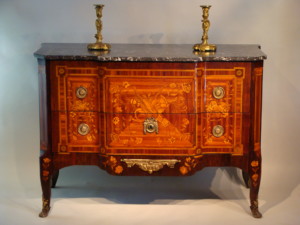
The fashion for marquetry reached its high point in France in the later 18th century, with many fine pieces unfortunately destroyed just after the Revolution.
Many fine marquetry pieces were reproduced in the 19th century, and are in their own right much sought after by collectors.
These reproductions can fetch quite high prices, particularly when signed.
Originals and copies can be seen in Waddesdon Manor, Aylesbury, UK and also at the Wallace Collection in London.
There were some great cabinet makers working in marquetry in England. One of the greatest was Pierre Langlois (French national) who worked in London and supplied many masterpieces to wealthy English Collectors and the Nobility of the 18th century.
The great English master cabinet makers working in marquetry produced some of the finest furniture ever made, for example Thomas Sheraton, Chippendale, Adam and Hepplewhite are some of the most famous.
[/fusion_builder_column][fusion_builder_column type=”1_1″ background_position=”left top” background_color=”” border_size=”” border_color=”” border_style=”solid” spacing=”yes” background_image=”” background_repeat=”no-repeat” padding=”” margin_top=”0px” margin_bottom=”0px” class=”” id=”” animation_type=”” animation_speed=”0.3″ animation_direction=”left” hide_on_mobile=”no” center_content=”no” min_height=”none”]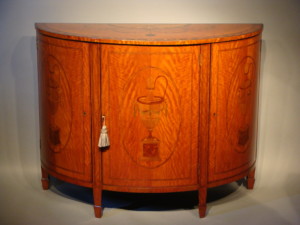
[/fusion_builder_column][/fusion_builder_row][/fusion_builder_container]



